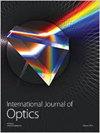Nonlinear All-Optical Diffractive Deep Neural Network with 10.6 μm Wavelength for Image Classification
IF 1.8
4区 物理与天体物理
Q3 OPTICS
引用次数: 5
Abstract
A photonic artificial intelligence chip is based on an optical neural network (ONN), low power consumption, low delay, and strong antiinterference ability. The all-optical diffractive deep neural network has recently demonstrated its inference capabilities on the image classification task. However, the size of the physical model does not have miniaturization and integration, and the optical nonlinearity is not incorporated into the diffraction neural network. By introducing the nonlinear characteristics of the network, complex tasks can be completed with high accuracy. In this study, a nonlinear all-optical diffraction deep neural network (N-D2NN) model based on 10.6 μm wavelength is constructed by combining the ONN and complex-valued neural networks with the nonlinear activation function introduced into the structure. To be specific, the improved activation function of the rectified linear unit (ReLU), i.e., Leaky-ReLU, parametric ReLU (PReLU), and randomized ReLU (RReLU), is selected as the activation function of the N-D2NN model. Through numerical simulation, it is proved that the N-D2NN model based on 10.6 μm wavelength has excellent representation ability, which enables them to perform classification learning tasks of the MNIST handwritten digital dataset and Fashion-MNIST dataset well, respectively. The results show that the N-D2NN model with the RReLU activation function has the highest classification accuracy of 97.86% and 89.28%, respectively. These results provide a theoretical basis for the preparation of miniaturized and integrated N-D2NN model photonic artificial intelligence chips.10.6的非线性全光衍射深度神经网络 μm波长用于图像分类
光子人工智能芯片基于光神经网络,具有低功耗、低延迟、抗干扰能力强等特点。全光衍射深度神经网络最近在图像分类任务中展示了其推理能力。然而,物理模型的尺寸不具有小型化和集成化,并且光学非线性没有被纳入衍射神经网络。通过引入网络的非线性特性,可以高精度地完成复杂的任务。在本研究中,一个基于10.6的非线性全光衍射深度神经网络(N-D2NN)模型 μm波长是通过将ONN和复值神经网络相结合,并在结构中引入非线性激活函数来构建的。具体而言,整流线性单元(ReLU)的改进激活函数,即Leaky ReLU、参数ReLU(PReLU)和随机化ReLU(RReLU),被选择作为N-D2NN模型的激活函数。通过数值模拟,证明了基于10.6的N-D2NN模型 μm波长具有出色的表示能力,使他们能够分别很好地执行MNIST手写数字数据集和Fashion MNIST数据集的分类学习任务。结果表明,具有RReLU激活函数的N-D2NN模型具有最高的分类准确率,分别为97.86%和89.28%。这些结果为制备小型化、集成化的N-D2NN模型光子人工智能芯片提供了理论依据。
本文章由计算机程序翻译,如有差异,请以英文原文为准。
求助全文
约1分钟内获得全文
求助全文
来源期刊

International Journal of Optics
Physics and Astronomy-Atomic and Molecular Physics, and Optics
CiteScore
3.40
自引率
5.90%
发文量
28
审稿时长
13 weeks
期刊介绍:
International Journal of Optics publishes papers on the nature of light, its properties and behaviours, and its interaction with matter. The journal considers both fundamental and highly applied studies, especially those that promise technological solutions for the next generation of systems and devices. As well as original research, International Journal of Optics also publishes focused review articles that examine the state of the art, identify emerging trends, and suggest future directions for developing fields.
 求助内容:
求助内容: 应助结果提醒方式:
应助结果提醒方式:


